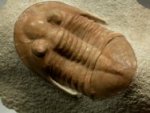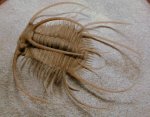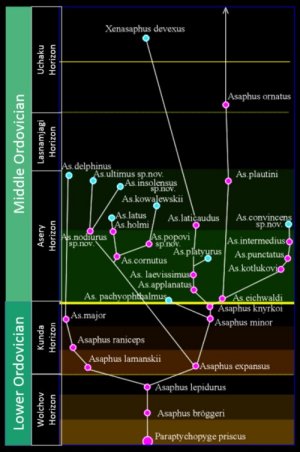Russian Trilobites
|
|
The
Cambrian is one of the most sensational periods of paleobiology on earth.
An explosion of diversity and form of eukaryotic
life occurred resulting in the appearance of most major phyla of life extant
to day, as well as other phyla that appeared and disappeared. By the Ordovician
(504 to 441 million years ago), the outcome of the solar energy- and floral
oxygen-driven Cambrian explosion was manifest in the still accelerating diversity
of trilobites (fewer families than in the Cambrian, but more morphological
variation). With 100 million years of selective pressure behind them, the
trilobites
from While the 20 million year span, give or take a million, that begins the Cambrian period known as the Cambrian Explosion gets all the glory, the Lower Ordovician was pretty spectacular itself in terms of marine animal diversity expansion. In fact, some call it “The Great Ordovician Radiation”, or even “The Ordovician Explosion”. The Cambrian – Ordovician extinction even was pretty severe for some marine life, trilobites among them. This, of course, cleared out the ecosystems, and left a lot of niches to be filled by newer evolved forms. Trilobites responded with a long run of new adaptations, fostered by shallow coastal waters and increasingly complex reef systems. Evolutionary sequences among Russian asaphid trilobitesNowhere is this
great Ordovician radiation better illustrated than the region around
Saint Petersburg, Russia that during the period was part of a shallow
inland sea. Saint Petersburg sits atop an enormous limestone mass, teeming
with preserved trilobites. Evidence has led scientists to conjecture that
the inland sea basin sea was The matrix of the region is soft for limestone, and preserves the trilobites in apparently near full three dimensional high relief. Especially the Asaphids (like many asaphids worldwide in the Ordovician) can be quite large. The result, with professional preparation, are exquisite chocolate trilobites on light limestone. Many trilobite orders and families come from the strata. Besides prodigious asaphids of family Asaphidae, Illaenidae and Remopleuridae are also represented. Pliomeridae, Cheiruridae, Encrinuridae and Phacopidae are among Phacopids found. Super spiny members of the Lichadidae come from the area, as well as Harpedidea, the least prevalent of all trilobite orders. There are some 20 genera known, and more than a hundred species. The Ordovician trilobites from Saint Petersburg dwindle and then disappear in the upper horizons. This roughly corresponds to a time frame when trilobite domination of reef systems worldwide was being diminished by an ever increasing diversity of competing animals and predators. The later descendants also lose their impressive eyestalks, as the opening from the inland sea reopened, reducing turbidity and the survival need for them. Such descent with modification is an exemplar of evolution, just as Darwin observed in finch populations with different beak sizes in the Galápagos Islands. |
|




